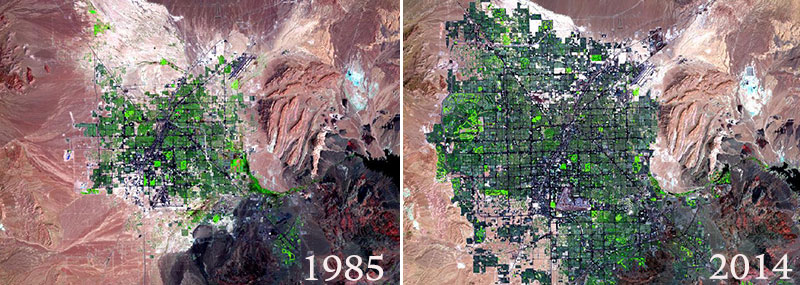
Courtesy of Larry Boneau
For more than two decades, the Yale Center for Earth Observation has served as a nexus for University-wide research efforts in areas as varied as geology, epidemiology and anthropology. Now, as satellite-based remote sensing technology becomes more widespread and powerful, the YCEO is celebrating 25 years.
A research center within the Yale Institute of Biospheric Studies, the YCEO provides students and faculty with opportunities to incorporate remote sensing techniques into their research endeavors. The center, located in the School of Forestry & Environmental Studies Environmental Science Center building, was founded in 1992 by Ronald Smith, a professor in the geology and geophysics department. In establishing the YCEO, Smith said that he hoped to make satellite data more accessible for faculty and students interested in earth science research, especially since only a few of his colleagues had experience with remote sensing technology.
Over the past quarter-century, the YCEO has continued to provide the campus with software, educational support and other tools to engage the rapidly expanding field of remote sensing.
“We were ‘riding a wave’ in a sense because new satellite sensors; faster, cheaper computers and new research problems came along very fast,” Smith said. “We had to race just to keep up. Not surprisingly, student interest grew too.”
Today, the YCEO draws students from Yale College and the University’s professional schools. According to YCEO Manager Larry Bonneau, while the majority of YCEO student researchers are affiliated with F&ES, the center also attracts undergraduate and graduate students from fields as diverse as history, architecture, public health and archaeology.
Unlike the remote sensing facilities used at other schools, the YCEO is not affiliated with a particular lab or department at Yale. F&ES professor Xuhui Lee, who recently took over as the center’s new director, said that this feature allows the YCEO to assist research efforts from all over the campus. He added that the center also focuses more on the application of remote sensing technology, rather than developing products themselves, as centers at other universities often do.
Recent advances in remote sensing are especially important today, Smith said, because this monitoring capability “comes at a time of rapid human-induced change in our planet.” Over the last couple of decades, a big change in the field is that data produced by environmental satellites is now available to anybody in the world, Lee added.
“Because data is publicly available, we can monitor places we otherwise don’t have access to,” Lee said. “It removes legal and logistical restrictions, which is so important for environmental monitoring. If you analyze local data, it may be screened for [some] reason, but with remote sensing, it’s unbiased and makes it difficult to hide problems. Everything is more open and more transparent.”
According to Bonneau, one of the most worthwhile parts of managing the YCEO is seeing the impact made by students who were introduced to remote sensing at Yale. Many students have gone into careers that rely heavily on satellite imagery, while some have even established remote sensing centers at other universities, he added.
Karina Yager GRD ’09, who became involved with the center while completing her Ph.D. in anthropology, said that the YCEO had a “major influence” on her academic interests, research and career. Now a professor at Stony Brook University, Yager said that she continues her remote sensing research today to monitor land cover and land use change in the Andes Mountains.
“In my opinion, I couldn’t have asked for more,” Yager said. “[The YCEO] was the perfect place for learning about remote sensing, connecting with others on current and interdisciplinary research and [having] access to an incredible lab and research support network.”
In addition to hosting workshops to guide students through the basics of image analysis, the YCEO also offers a course every spring semester -— “Observing Earth from Space,” co-taught by Lee and Bonneau. While it serves as a practical introduction to the theory and application of satellite remote sensing, the class also incorporates weekly lab exercises that challenge students to solve real-world problems in environmental science, Lee said.
Cameron Yick ’17, a computer science major, said that he chose to take “Observing Earth from Space” because it offered a unique opportunity to work with data and software available only through University resources. He added that because he is interested in exploring data journalism and environmental nonprofit organizations after graduation, the class provides valuable exposure to the techniques available in the field.
“When you hear news today about the environment, so much of the data supporting the underlying claims are collected by satellite, whether it’s carbon in the atmosphere or pollution in the water,” Yick said. “I thought it would be cool to understand the studies that people don’t usually read so that I can be a more informed person.”
Looking forward to its next 25 years, the YCEO hopes to strengthen its connections with various departments on campus, Lee said. Smith added that he hopes the center’s existing facilities can be supplemented with GIS activity and climate simulation tools, an expansion of the center’s capabilities that could lift the University’s position in environmental science.
According to Lee, the YCEO also looks forward to embracing a newer technology: drones. Although drones are limited in their range of coverage, they can provide on-demand image acquisition, leading to the creation of localized, detailed surveys that complement global coverage obtained from satellites, he said.
The Yale Center for Earth Observation was designated a NASA Center of Excellence in 1997.







